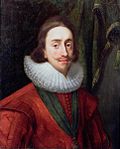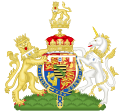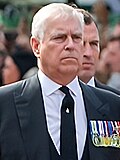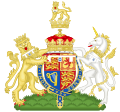Dukes of York
First creation, 1385–1461
| Duke | Portrait | Birth | Marriage(s) | Death |
|---|---|---|---|---|
| Edmund of Langley 1385–1402 [19] also: Earl of Cambridge (1362) |  | 5 June 1341 Kings Langley 4th surviving son of King Edward III and Philippa of Hainault | Isabella of Castile 11 July 1372 - 23 December 1392 3 children Joan Holland c. 4 November 1393 no children | 1 August 1402 |
| Edward of Norwich 1402–1415 [20] also: Duke of Aumale (1397–1399), Earl of Cambridge (1362–1414), Earl of Rutland (1390–1402), Earl of Cork (c. 1396) |  | 1373 Norwich son of 1st Duke by his first wife Isabella of Castile | Philippa de Mohun no children | 25 October 1415 Battle of Agincourt aged 42 |
| Richard of York 1415–1460 also: Lord Protector of England (1460, see Act of Accord); Earl of Ulster (1264), Earl of March (1328), Earl of Cambridge (1414, restored 1426), feudal Lord of Clare (bt. 1066–1075), Baron Mortimer of Wigmore (1331) |  | 21 September 1411 Nephew of 2nd Duke and son of Richard of Conisburgh, 3rd Earl of Cambridge (attainted and executed for treason in August 1415) and Anne de Mortimer; restored in blood | Cecily Neville 1437 13 children | 30 December 1460 Wakefield aged 49 |
| Edward Plantagenet 1460–1461 [21] also: Earl of Ulster (1264), Earl of March (1328), Earl of Cambridge (1414), feudal Lord of Clare (bt. 1066–1075), Baron Mortimer of Wigmore (1331) |  | 28 April 1442 Rouen son of 3rd Duke by his wife Cecily Neville | Elizabeth Woodville 1 May 1464 10 children | 9 April 1483 Westminster aged 40 |
| Edward Plantagenet seized the throne in 1461 as Edward IV and the title of duke merged in the crown. | ||||
Second creation, 1474
| Duke | Portrait | Birth | Marriage(s) | Death |
|---|---|---|---|---|
| Richard of Shrewsbury 1474–1483 also: Duke of Norfolk (1477), Earl of Norfolk (1477), Earl of Nottingham (1476), possibly Earl of Warenne (1477) |  | 17 August 1473 Shrewsbury Second son of King Edward IV and Elizabeth Woodville | Anne de Mowbray 15 January 1478 no children | Disappeared in the Tower of London, with his older brother, the "Princes in the Tower". |
| Richard disappeared without issue and the title of duke became extinct. | ||||
Third creation, 1494
| Duke | Portrait | Birth | Marriage(s) | Death |
|---|---|---|---|---|
| Henry Tudor 1494–1509 [22] also: Prince of Wales (1504), Duke of Cornwall (1502) |  | 28 June 1491 Greenwich Palace, London son of Henry VII and Elizabeth of York | Catherine of Aragon 11 June 1509 – 23 May 1533 (annulment) 1 surviving daughter, others stillborn or briefly-lived Anne Boleyn 25 January 1533 – 17 May 1536 (annulment) 1 daughter Jane Seymour 30 May 1536 – 24 October 1537 1 son Anne of Cleves 6 January 1540 – 9 July 1540 (annulment) no children Catherine Howard 28 July 1540 – 23 November 1541 no children Catherine Parr 12 July 1543 no children | 28 January 1547 Whitehall Palace, London aged 55 |
| Henry succeeded as Henry VIII in 1509 upon his father's death and the title of duke merged with the crown. | ||||
Fourth creation, 1605
| Duke | Portrait | Birth | Marriage(s) | Death |
|---|---|---|---|---|
| Charles Stuart 1605–1625 [23] also: Duke of Albany (1600); Prince of Wales (1616), Duke of Cornwall and Duke of Rothesay (1612) |  | 19 November 1600 Dunfermline Palace, Dunfermline son of James I and Anne of Denmark | Henrietta Maria of France 13 June 1625 9 children | 30 January 1649 Whitehall Palace, London aged 48 |
| Charles succeeded as Charles I in 1625 upon his father's death and the title of duke merged with the crown. | ||||
Fifth creation, 1633/1644
James was styled Duke of York from birth and officially created as such in 1644.
| Duke | Portrait | Birth | Marriage(s) | Death |
|---|---|---|---|---|
| James Stuart 1633/1644–1685 [24] also: Duke of Albany (1660), Earl of Ulster (1659) |  | 14 October 1633 St. James's Palace, London son of Charles I and Henrietta Maria of France | Anne Hyde 3 September 1660 8 children Mary of Modena 21 November 1673 7 children | 16 September 1701 Château de Saint-Germain-en-Laye, Paris aged 67 |
| James succeeded as James II in 1685 upon his brother's death and the title of duke merged with the crown. | ||||
Jacobite creation, 1725
| Duke | Portrait | Birth | Marriage(s) | Death |
|---|---|---|---|---|
| Henry Benedict Stuart 1725–1788 [24] also: Cardinal of the Holy Roman Church (1747), Dean of the College of Cardinals (1803) |  | 6 March 1725 Palazzo Muti Rome Papal States son of "James III and VIII" (Jacobite Pretender) and Maria Clementina Sobieska | ____ | 13 July 1807 Frascati, Rome aged 82 |
| Henry succeeded his brother as Jacobite pretender to the thrones of England, Ireland and Scotland in 1788, calling himself "Henry IX", but was not recognized in Britain as a Duke, let alone as King. | ||||
Sixth creation, 1892
| Duke | Portrait | Birth | Marriage(s) | Death | Arms |
|---|---|---|---|---|---|
| George Frederick Ernest Albert House of Saxe-Coburg and Gotha 1892–1910 also: Earl of Inverness and Baron Killarney (1892); Prince of Wales, Duke of Cornwall, and Duke of Rothesay (1901) |  | 3 June 1865 Marlborough House son of Edward VII and Alexandra of Denmark | Mary of Teck 6 July 1893 6 children | 20 January 1936 Sandringham House, Sandringham aged 70 |  |
| George succeeded as George V in 1910 upon his father's death and the title of duke merged with the crown. | |||||
Seventh creation, 1920
| Duke | Portrait | Birth | Marriage(s) | Death | Arms |
|---|---|---|---|---|---|
| Albert Frederick Arthur George House of Windsor 1920–1936 [25] also: Earl of Inverness and Baron Killarney (1920) |  | 14 December 1895 York Cottage, Sandringham son of George V and Mary of Teck | Elizabeth Bowes-Lyon 26 April 1923 2 daughters | 6 February 1952 Sandringham House, Sandringham aged 56 |  |
| Albert succeeded as George VI in 1936 upon his brother's abdication and the title of duke merged with the crown. | |||||
Eighth creation, 1986
| Duke | Portrait | Birth | Marriage(s) | Arms | |
|---|---|---|---|---|---|
| Andrew Albert Christian Edward House of Windsor 1986 [26] –present also: Earl of Inverness and Baron Killyleagh (1986) |  | 19 February 1960 Buckingham Palace son of Elizabeth II and Prince Philip, Duke of Edinburgh | Sarah Ferguson 23 July 1986 – 30 May 1996 (divorce) 2 daughters |  | |
| On 17 October 2025, Andrew announced he would no longer use the title "Duke of York" and its subsidiary titles. [27] On 30 October 2025, Buckingham Palace announced formal proceedings to remove the titles from Andrew had begun, along with the right to be titled "prince", and he would be known as Andrew Mountbatten-Windsor. [28] As of 30 October 2025, his name has been removed from the Roll of the Peerage . [29] [30] However, while this strips him of the right to use the title, the title can actually be removed only by an act of Parliament. [31] The title will not be issued again until Andrew's death. [32] | |||||
